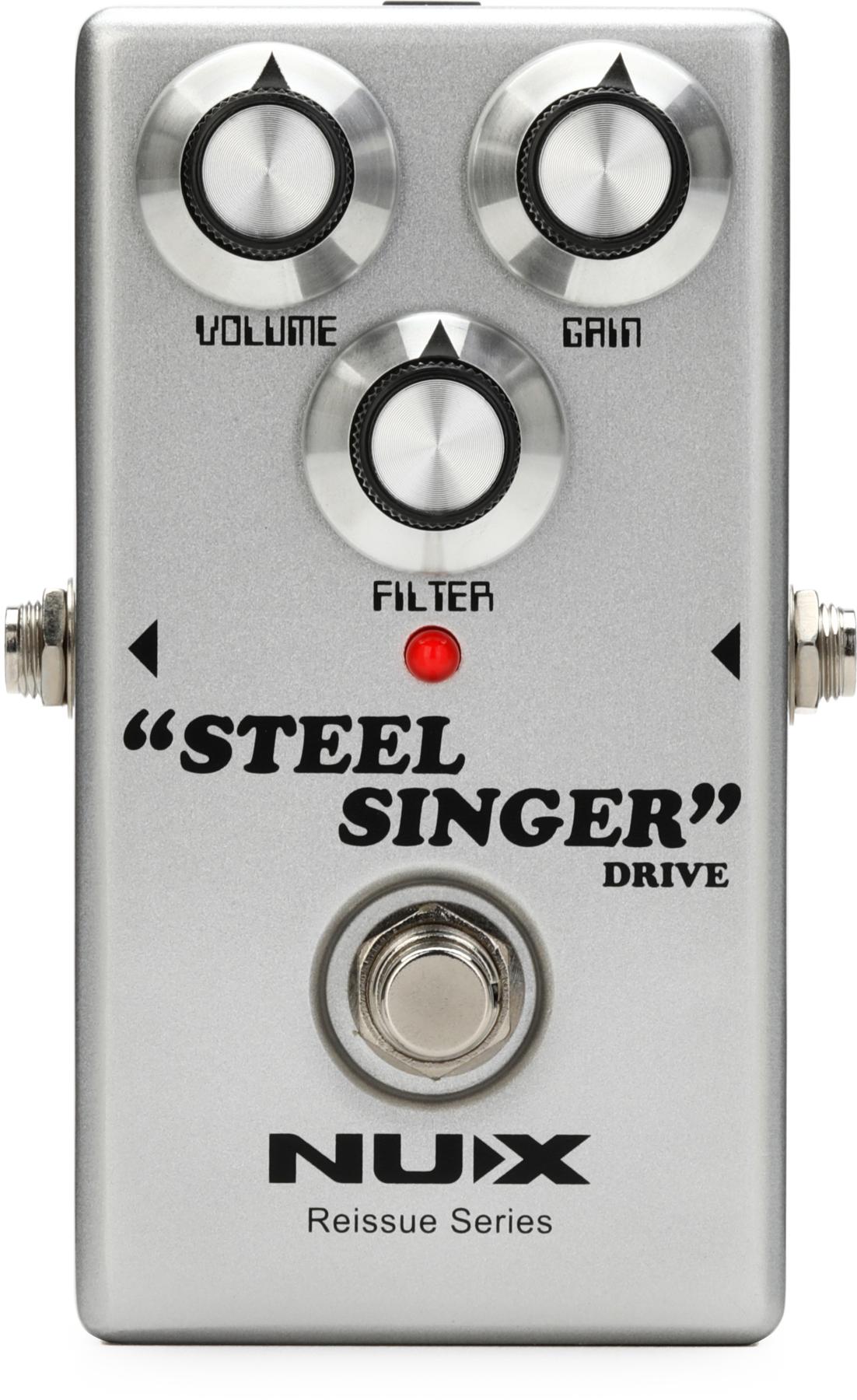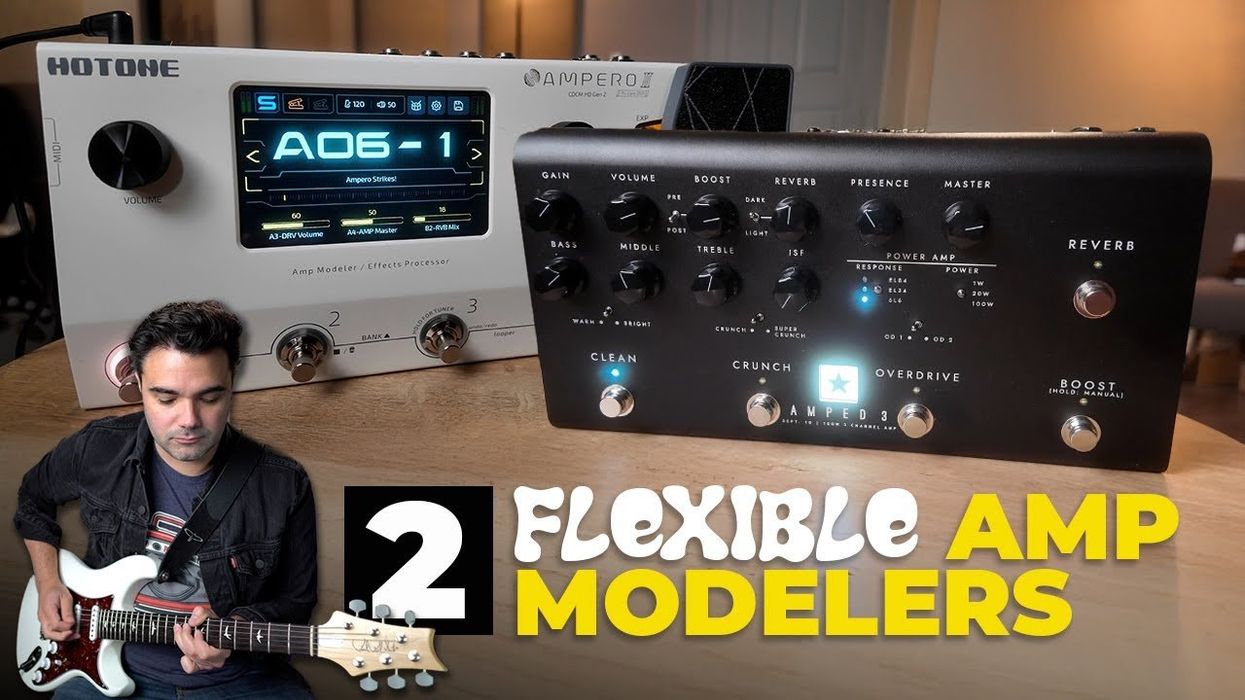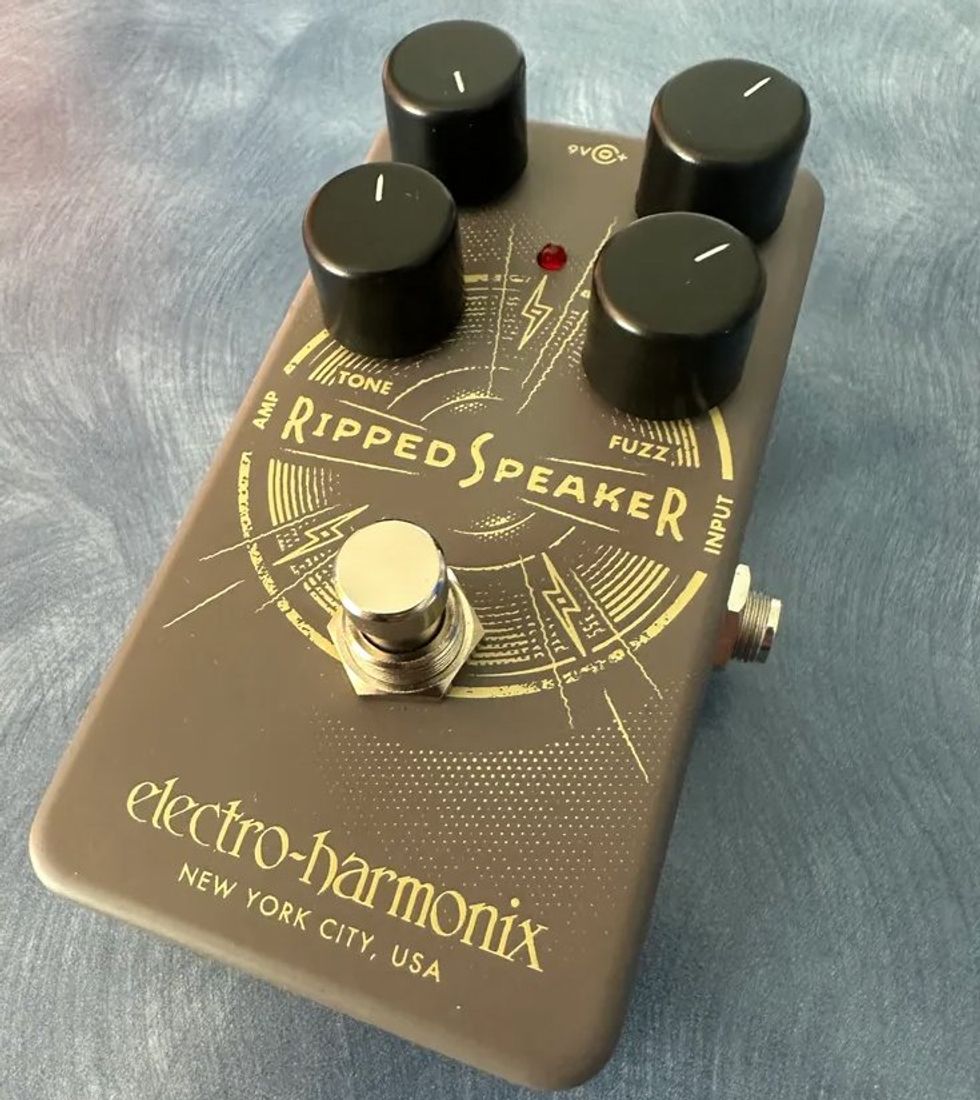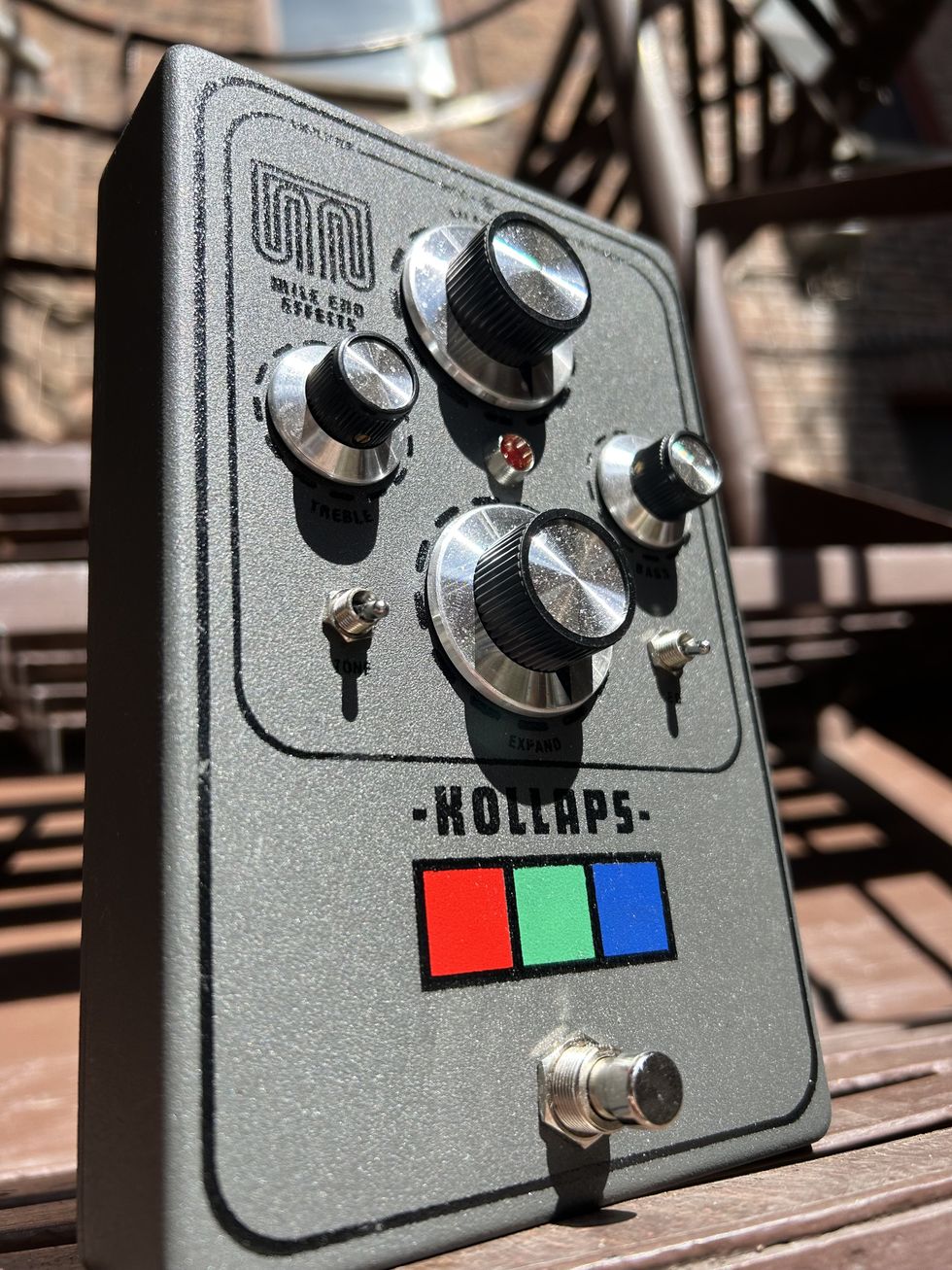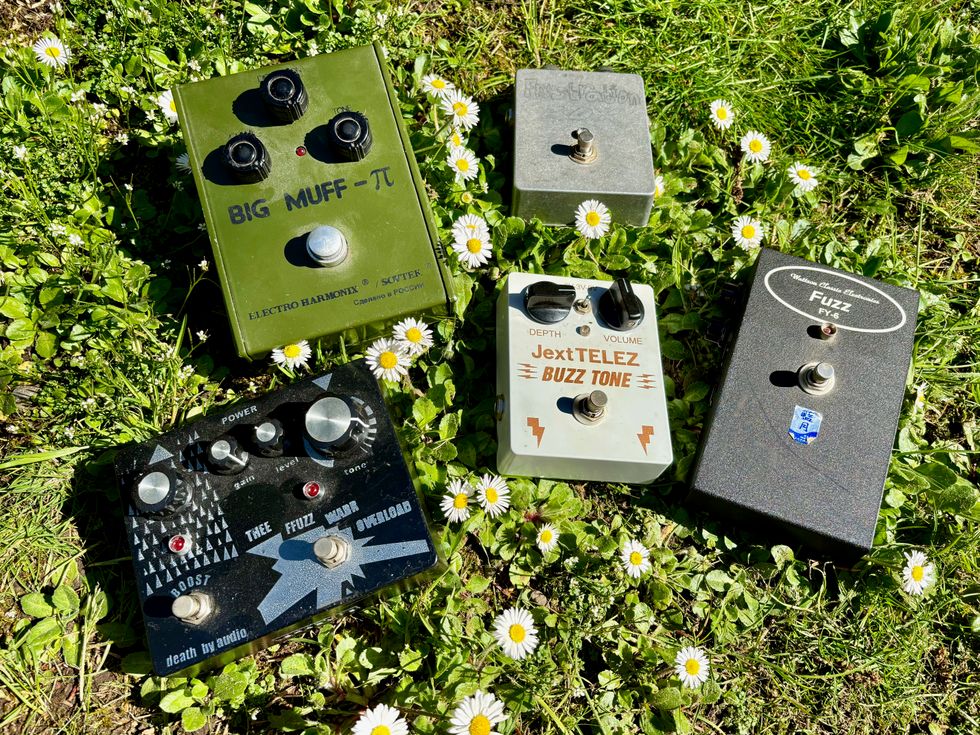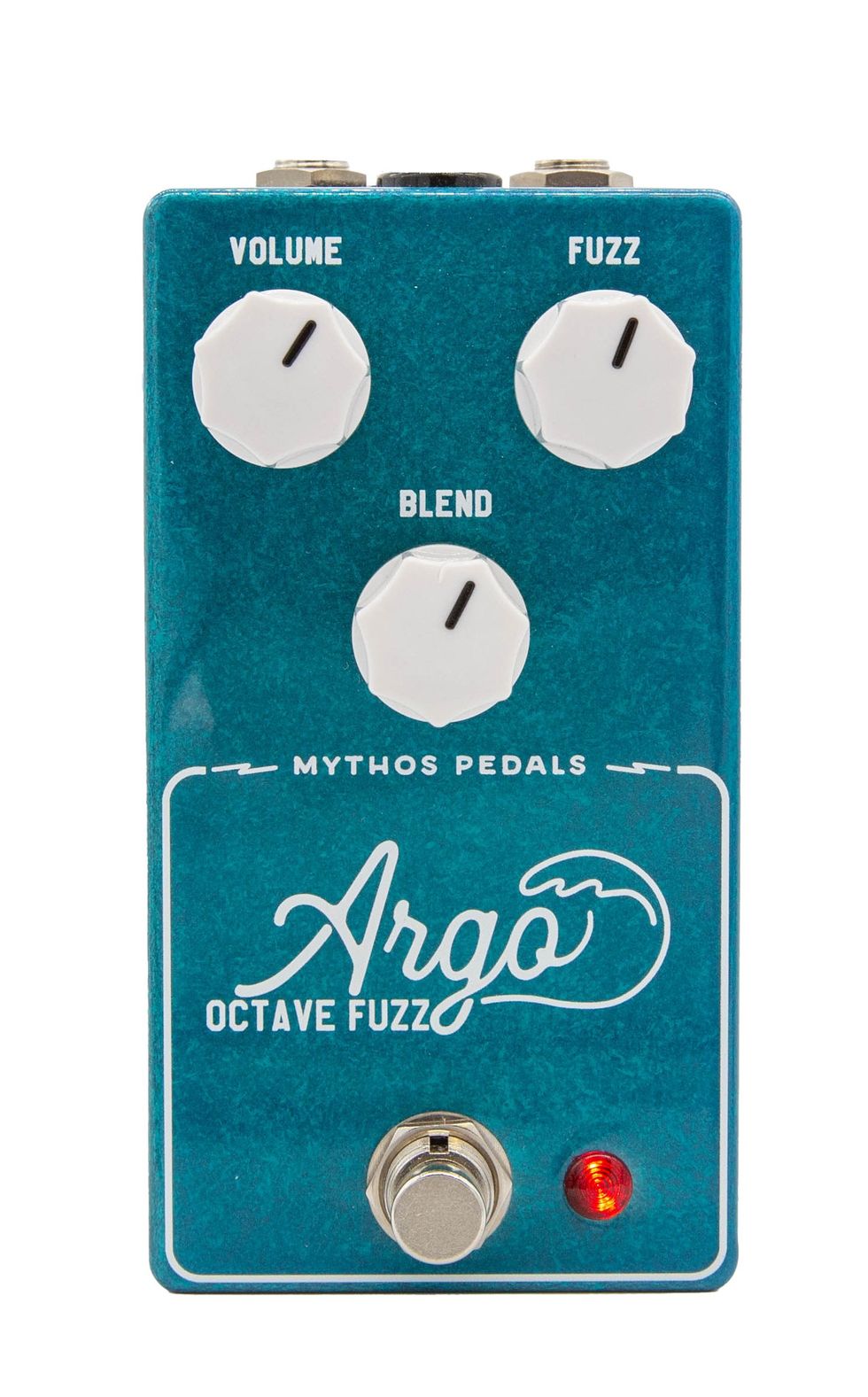When I first got into studying the
jazz tradition, as a guitarist I was
immediately drawn to Charlie Christian,
John Scofield, Wes Montgomery, and Bill
Frisell. As I expanded my listening scope,
I’d go back further into history to the early
jazz of Louis Armstrong and Jelly Roll
Morton, who employed the remarkable
and under-appreciated guitarists Bernard
Addison and Lawrence Lucie.
This inevitably led to the Delta blues of Robert Johnson and Son House, and the great ragtime guitarists Blind Blake and Rev. Gary Davis, who played in the “Piedmont” style. The more I listened, the more I saw a connection between those men and the stride piano tradition of Willie “The Lion” Smith, Fats Waller, and James P. Johnson. Using Piedmont-style guitar as a jumping off point, I tried to stretch that sound and style into something that more closely approximated the techniques of a stride pianist. In the course of doing so, obviously, it becomes something in and of itself. But that’s part of what makes music so much fun. Trying to do things that are unconventional ultimately leads to something new and different. That doesn’t always mean it sounds good, but it’s important to try, right?
I enjoy using this style when accompanying a singer or horn player in a duo setting. It’s a nice change of pace from the usual roles of walking bass lines and comping à la Joe Pass, or playing a chord on every beat to mimic Freddie Green’s big-band rhythm sound.
As with any new style, it’s vitally important to listen to the music you’re trying to emulate. The original concept of stride piano was to emulate the bands of New Orleans in the early 20th century. Stride pianists covered the tuba and banjo parts with the left hand while playing melodies with the right hand. Combining all of this on a standard 6-string guitar is a bit tricky, but I learned a lot from listening to Tuck Andress and Charlie Hunter. It’s what you imply in your playing that makes what you actually do play stand out so much. The basic idea is to establish the root or 5th of each chord on the lowest two strings, while hitting other chord tones on the upper strings.
While it may be possible to play some of these exercises using a pick or hybrid pickand- fingers technique, I prefer using a pure fingerstyle method in order to better imitate the sound of stride piano. One of the main benefits is that you can hit the strings in different places to get distinctive timbres out of the bass notes and chords. For instance, if you hit the bass notes closer to the fretboard, they will be boomier and more resonant. If you pluck the chords closer to the bridge, they will be sharper and punchier. I learned how to do this by trying to cop Duke Ellington and Thelonious Monk’s use of the pedal positions on the piano. They could get a wide array of colors out of the piano, and I wanted to find a way to incorporate that into my guitar playing. Check out Duke’s Piano Reflections and Monk’s Solo Monk for the best examples of this concept.
To begin, let’s look at some standard rhythm changes in the key of Bb as shown in Fig. 1. When learning any new technique, it’s essential to play along with a metronome clicking on beats 2 and 4, but be sure to start slowly. Developing this technique requires your brain to do some serious multitasking, and you always have to be thinking a few beats ahead to know where you are going. Working slowly allows the muscles in your hand (and skull) to learn what they need to do properly so that later on, when you bump up that tempo, they are well accustomed to all the moves.
Download Example Audio...

In Fig. 2, things get a little trickier by adding the 3rd tone of the chord on beats 1 and 3. By raising the 3rd up an octave, you create the interval of a tenth, which pianists have been abusing for years in all styles of music. The previous two examples require some big leaps across the fretboard, so let’s look at a way to do less leaping and more stretching. Fig. 3 is a real finger- and mind-bender, but sounds pretty impressive when you get it down. Using some chromatically descending standard chord changes, we can really get a lot going on at once. This one is in the key of Eb. I’m purposely avoiding traditional “guitar” keys, so that you can work without the benefit of open strings. But you can apply these techniques to other key signatures and give your hands more freedom by playing in the keys of E, A, or D.
Download Example Audio...

Download Example Audio...

Taking those changes as a guideline, we can get a little bit fancier in between the basic bass/chord pattern. Check out Fig. 4. By jumping between full chord shapes, we can add some fills to flesh out the sound a bit. In measures 3, 5, and 7, make sure to keep the high note ringing as long as possible. This adds to the illusion of having two parts occurring simultaneously.
Download Example Audio...

One of the most exciting things in stride happens when the pianist inserts a swinging, propulsive solo break into the bass/chord pattern. So let’s look at the Bb blues changes in Fig. 5 and put all these things together. There is a lot to absorb in this example, so let’s look at a few areas to watch out for. Try to play all the quarter-notes throughout the example as staccato as possible. Remember, the sound of stride piano has a real swinging, old-time feel. Keep everything relaxed and locked in with the metronome.
Download Example Audio...

In the 6th measure, we use some diminished 7th chords as a series of passing chords in order to head back to the I chord in measure 7. Since the shape of these chords is identical, they are pretty easy to move up and down the neck. In measure 11, we are combining some augmented triads to create a rolling lick that leads into the chromatically descending chords in the turnaround.
Finding new ways to approach playing your instrument is always a good thing. Breaking out of the well-worn guitar clichés can inject some fresh perspectives into your playing. It will also give you musical depth. Whether you are performing solo or as an accompanist, playing stride guitar will set you apart and turn some heads at the gig once you get it down. I encourage you to listen to all the players I mentioned above and find a way to get more of their sounds into the music you already know. Every instrument has a rich history and tradition, but they are all open to be folded into what we do as guitar players. The more you know, the better you sound!
 Doug Wamble
Doug Wamble
Since moving to New York City, Doug Wamble has performed and recorded with Wynton Marsalis, Cassandra Wilson, Branford Marsalis, Bill Frisell, and Charlie Hunter. He has composed and performed original works for the Lincoln Center Jazz Orchestra and Chamber Music America, and created film soundtracks for acclaimed documentarian Ken Burns. His new album is due later this year. For more information, visit dougwamble.com.
This inevitably led to the Delta blues of Robert Johnson and Son House, and the great ragtime guitarists Blind Blake and Rev. Gary Davis, who played in the “Piedmont” style. The more I listened, the more I saw a connection between those men and the stride piano tradition of Willie “The Lion” Smith, Fats Waller, and James P. Johnson. Using Piedmont-style guitar as a jumping off point, I tried to stretch that sound and style into something that more closely approximated the techniques of a stride pianist. In the course of doing so, obviously, it becomes something in and of itself. But that’s part of what makes music so much fun. Trying to do things that are unconventional ultimately leads to something new and different. That doesn’t always mean it sounds good, but it’s important to try, right?
I enjoy using this style when accompanying a singer or horn player in a duo setting. It’s a nice change of pace from the usual roles of walking bass lines and comping à la Joe Pass, or playing a chord on every beat to mimic Freddie Green’s big-band rhythm sound.
As with any new style, it’s vitally important to listen to the music you’re trying to emulate. The original concept of stride piano was to emulate the bands of New Orleans in the early 20th century. Stride pianists covered the tuba and banjo parts with the left hand while playing melodies with the right hand. Combining all of this on a standard 6-string guitar is a bit tricky, but I learned a lot from listening to Tuck Andress and Charlie Hunter. It’s what you imply in your playing that makes what you actually do play stand out so much. The basic idea is to establish the root or 5th of each chord on the lowest two strings, while hitting other chord tones on the upper strings.
While it may be possible to play some of these exercises using a pick or hybrid pickand- fingers technique, I prefer using a pure fingerstyle method in order to better imitate the sound of stride piano. One of the main benefits is that you can hit the strings in different places to get distinctive timbres out of the bass notes and chords. For instance, if you hit the bass notes closer to the fretboard, they will be boomier and more resonant. If you pluck the chords closer to the bridge, they will be sharper and punchier. I learned how to do this by trying to cop Duke Ellington and Thelonious Monk’s use of the pedal positions on the piano. They could get a wide array of colors out of the piano, and I wanted to find a way to incorporate that into my guitar playing. Check out Duke’s Piano Reflections and Monk’s Solo Monk for the best examples of this concept.
To begin, let’s look at some standard rhythm changes in the key of Bb as shown in Fig. 1. When learning any new technique, it’s essential to play along with a metronome clicking on beats 2 and 4, but be sure to start slowly. Developing this technique requires your brain to do some serious multitasking, and you always have to be thinking a few beats ahead to know where you are going. Working slowly allows the muscles in your hand (and skull) to learn what they need to do properly so that later on, when you bump up that tempo, they are well accustomed to all the moves.
Download Example Audio...
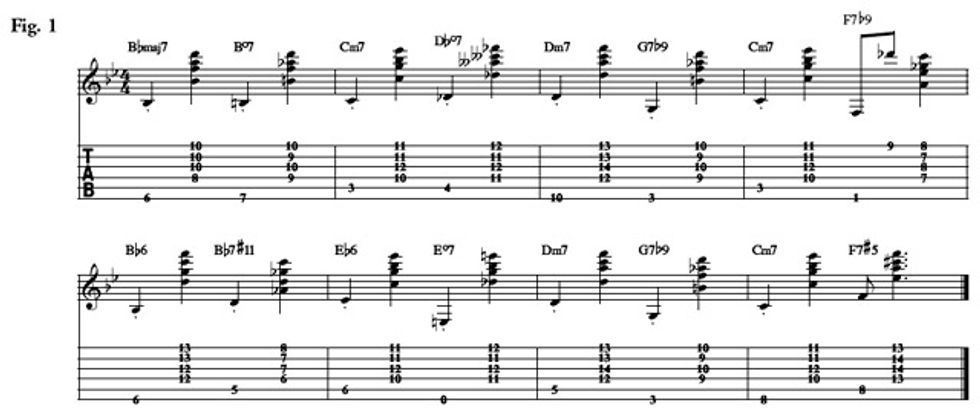
In Fig. 2, things get a little trickier by adding the 3rd tone of the chord on beats 1 and 3. By raising the 3rd up an octave, you create the interval of a tenth, which pianists have been abusing for years in all styles of music. The previous two examples require some big leaps across the fretboard, so let’s look at a way to do less leaping and more stretching. Fig. 3 is a real finger- and mind-bender, but sounds pretty impressive when you get it down. Using some chromatically descending standard chord changes, we can really get a lot going on at once. This one is in the key of Eb. I’m purposely avoiding traditional “guitar” keys, so that you can work without the benefit of open strings. But you can apply these techniques to other key signatures and give your hands more freedom by playing in the keys of E, A, or D.
Download Example Audio...

Download Example Audio...
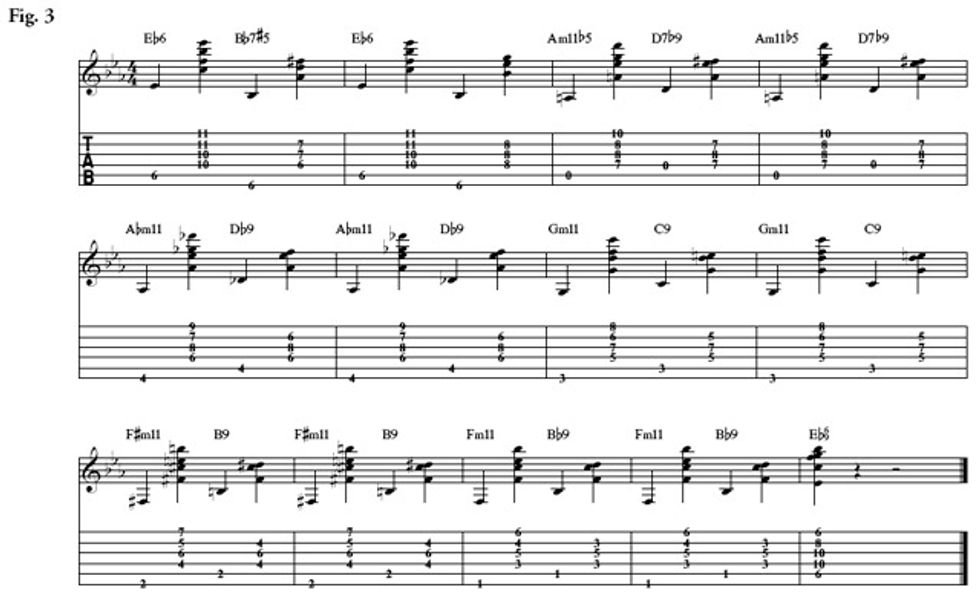
Taking those changes as a guideline, we can get a little bit fancier in between the basic bass/chord pattern. Check out Fig. 4. By jumping between full chord shapes, we can add some fills to flesh out the sound a bit. In measures 3, 5, and 7, make sure to keep the high note ringing as long as possible. This adds to the illusion of having two parts occurring simultaneously.
Download Example Audio...
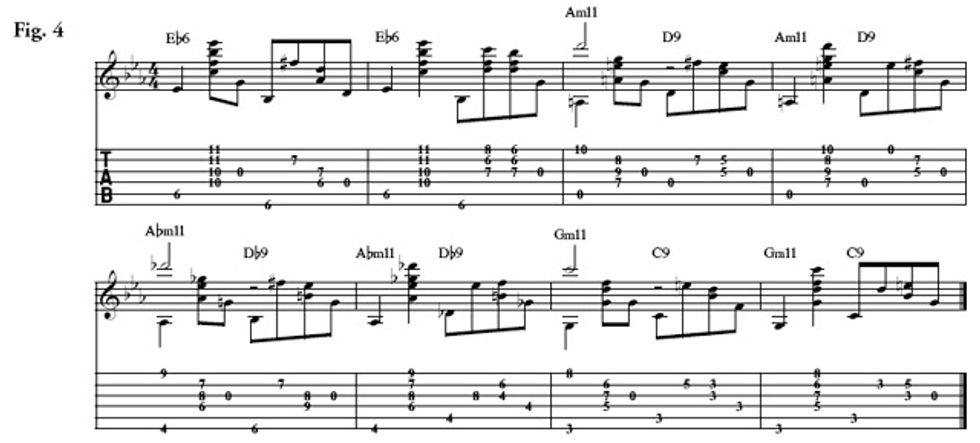
One of the most exciting things in stride happens when the pianist inserts a swinging, propulsive solo break into the bass/chord pattern. So let’s look at the Bb blues changes in Fig. 5 and put all these things together. There is a lot to absorb in this example, so let’s look at a few areas to watch out for. Try to play all the quarter-notes throughout the example as staccato as possible. Remember, the sound of stride piano has a real swinging, old-time feel. Keep everything relaxed and locked in with the metronome.
Download Example Audio...

In the 6th measure, we use some diminished 7th chords as a series of passing chords in order to head back to the I chord in measure 7. Since the shape of these chords is identical, they are pretty easy to move up and down the neck. In measure 11, we are combining some augmented triads to create a rolling lick that leads into the chromatically descending chords in the turnaround.
Finding new ways to approach playing your instrument is always a good thing. Breaking out of the well-worn guitar clichés can inject some fresh perspectives into your playing. It will also give you musical depth. Whether you are performing solo or as an accompanist, playing stride guitar will set you apart and turn some heads at the gig once you get it down. I encourage you to listen to all the players I mentioned above and find a way to get more of their sounds into the music you already know. Every instrument has a rich history and tradition, but they are all open to be folded into what we do as guitar players. The more you know, the better you sound!
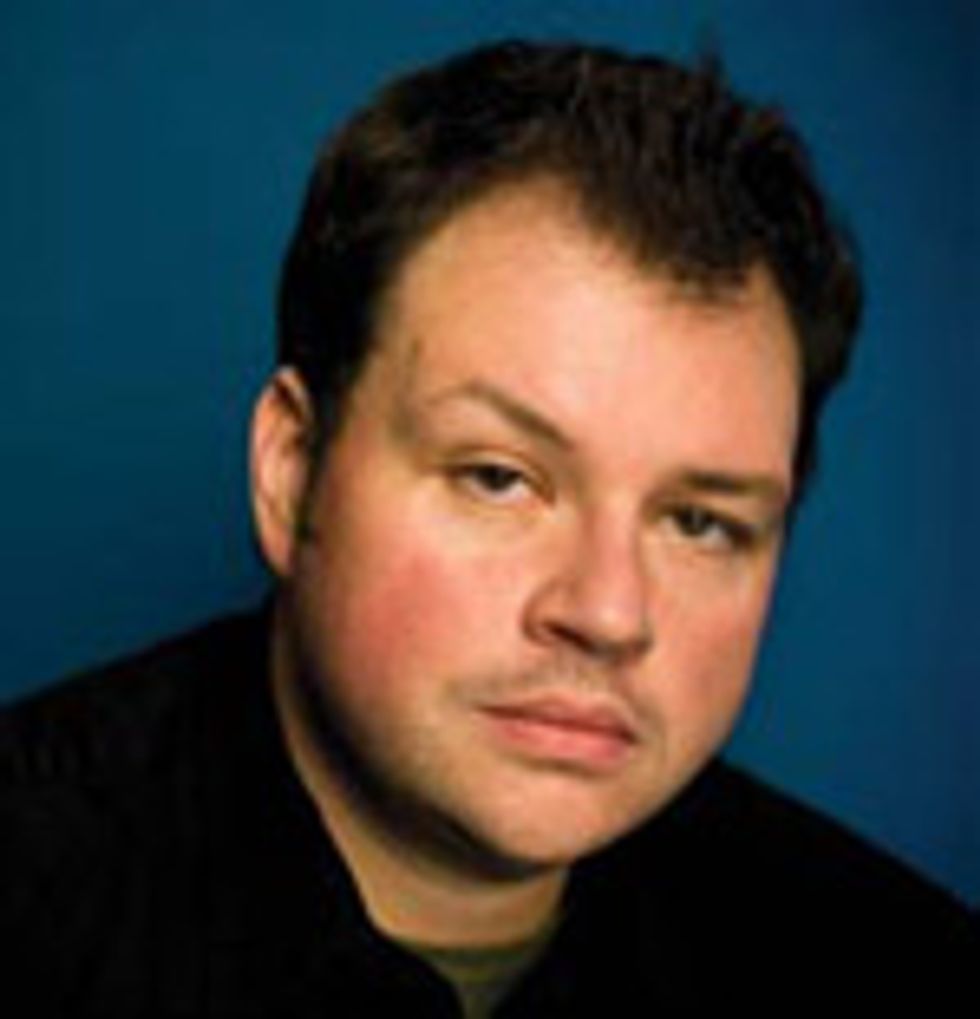 Doug Wamble
Doug WambleSince moving to New York City, Doug Wamble has performed and recorded with Wynton Marsalis, Cassandra Wilson, Branford Marsalis, Bill Frisell, and Charlie Hunter. He has composed and performed original works for the Lincoln Center Jazz Orchestra and Chamber Music America, and created film soundtracks for acclaimed documentarian Ken Burns. His new album is due later this year. For more information, visit dougwamble.com.


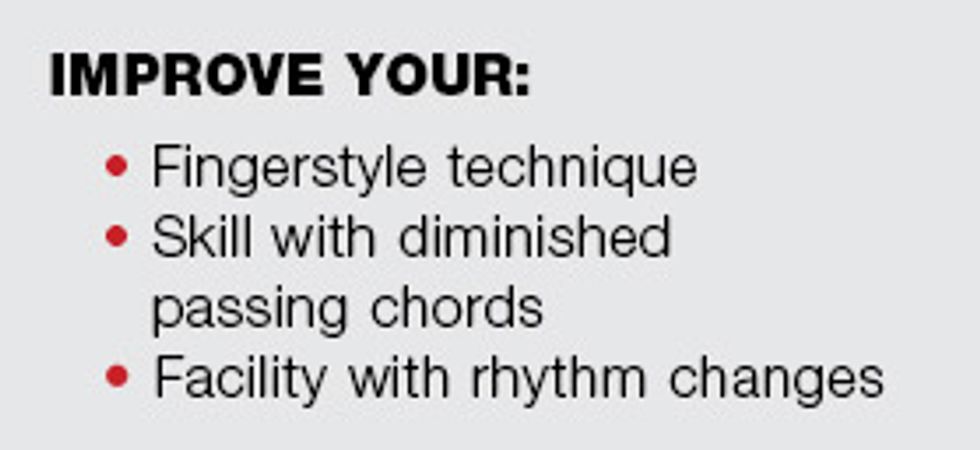
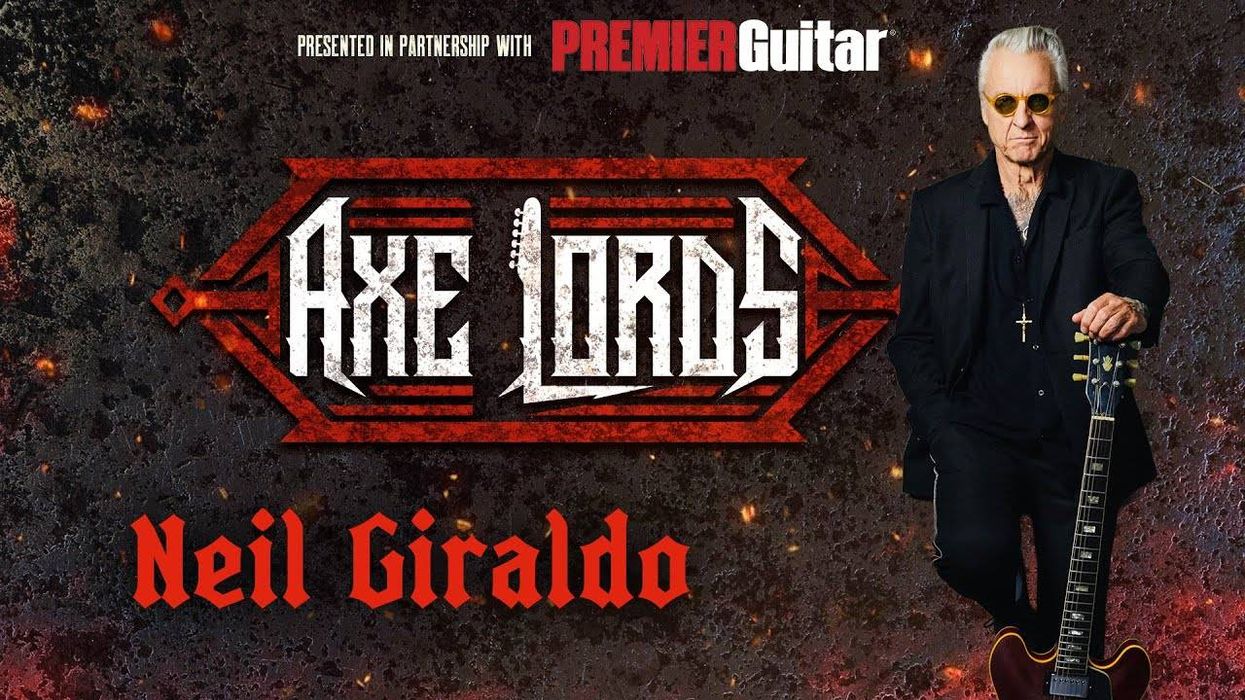

![Rig Rundown: Russian Circles’ Mike Sullivan [2025]](https://www.premierguitar.com/media-library/youtube.jpg?id=62303631&width=1245&height=700&quality=70&coordinates=0%2C0%2C0%2C0)


